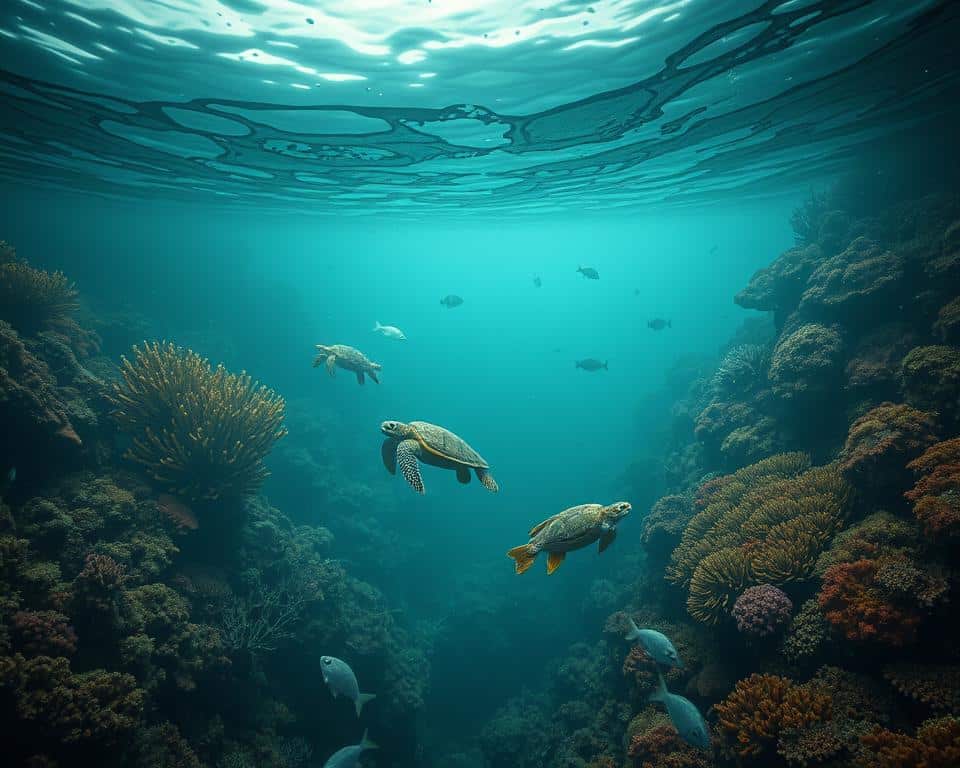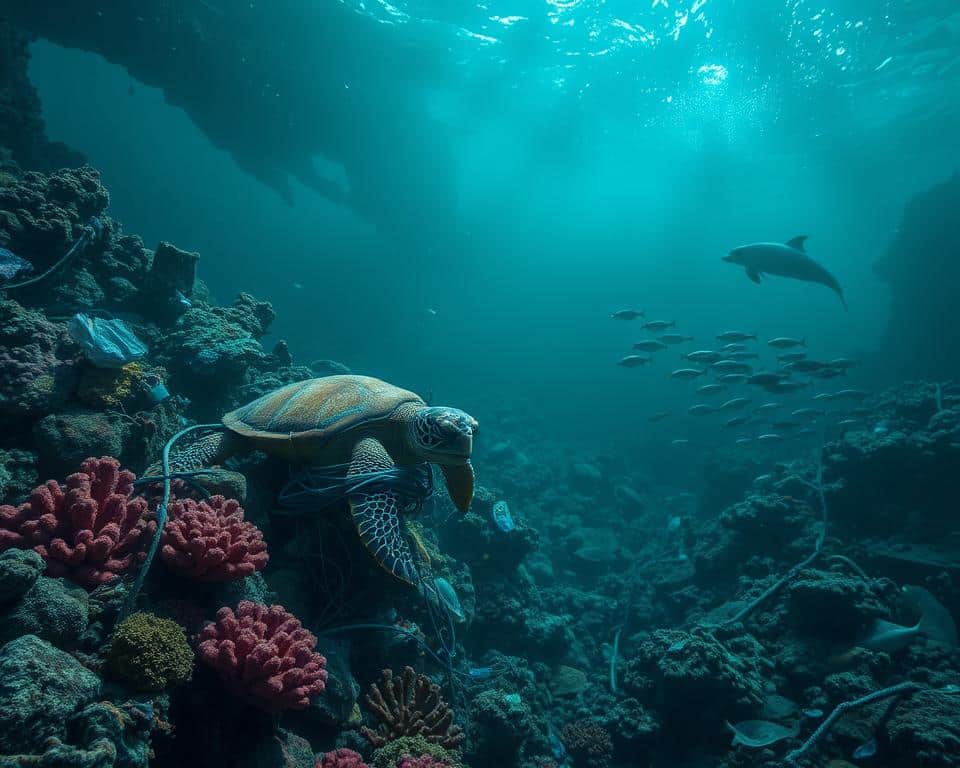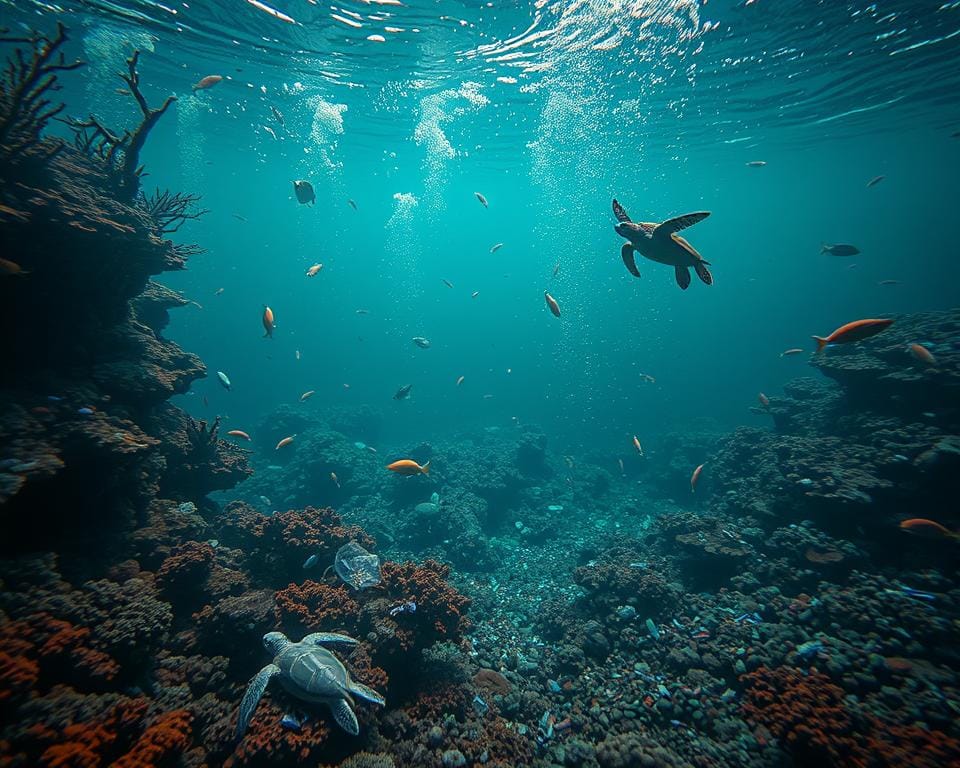The oceans cover 70% of Earth, vital for marine and human health. The National Oceanic and Atmospheric Administration (NOAA) reports that oceans receive billions of pounds of pollutants annually. This causes widespread ocean pollution.
About 80% of ocean pollution stems from land. Activities like runoff from roads, farms, and construction contribute to this. Furthermore, factories release harmful substances, like mercury, into the ocean. Accidents, like the 2010 Deepwater Horizon oil spill, show the extreme damage caused by 134 million gallons of oil leaking into the sea.
Pollution affects marine life immediately and can be deadly. It causes problems for creatures like dolphins, whales, and sharks by reducing oxygen and causing suffocation. Humans also suffer health issues from toxins in seafood.
For details on pollution and testing, check out this guide on how to test water for heavy metals.
Introduction to Water Pollution
Water pollution is a big problem for bodies of water around the world. It means putting harmful stuff—like chemicals and trash—into the ocean. Most of these bad substances come from places on land. They include harmful tiny life forms, waste that can rot, fertilizers, dangerous chemicals, dirt, heat, oil, and radioactive materials.
Household sewage is full of pathogens and organic matter that can make people sick. When sewage isn’t treated well, it can bring bacteria, viruses, and chemicals into our water. This can make drinking water and places where we swim unsafe. Resulting in diseases like cholera and hepatitis.
Every year, millions of tons of plastic end up in our oceans. Small plastic pieces, or microplastics, are a big worry. They’re found in water, sea animals, and even our drinking water. This trash hurts sea creatures and damages ocean homes.
Fertilizers washing into the sea can lead to too much algae growing. This uses up oxygen in the water, creating dead zones where sea life can’t live. Also, dangerous chemicals and heavy metals build up in sea animals. This can harm food chains and lead to serious health issues like cancer.
Industries releasing hot water into oceans make it harder for the water to hold oxygen. This harms fish and other sea life. Oil getting into the ocean from spills and city water runoff also damages the home of sea animals and activities on the beach.
Pollution reaching into groundwater is a big problem, too. It can come from leaky sewers, factories, and farms. This pollution puts our drinking water at risk and adds to the ocean’s problems. In the end, water pollution harms ecosystems, reduces the variety of life in the sea, and threatens many marine animals’ survival.
Sources of Water Pollution
Water pollution comes from many sources, each harming marine ecosystems greatly. Knowing these sources helps us fix and lessen the damage on nature and health.
Nonpoint Source Pollution
Nonpoint source pollution is hard to control because it doesn’t have one specific start point. It usually involves runoff from farms, car oil, and construction work. This runoff ends up in our rivers, lakes, and oceans.
In the US, farms are the biggest pollution source for rivers and streams, notes the NRDC. Colorado’s waters face threats from various pollutants, including metals and nutrients, showing the complexity of nonpoint source pollution.
Intentional Discharge
Intentional discharge means purposely putting toxic waste into waterways. This still happens around the world, even though some places have banned it. Industries sometimes release dangerous substances like mercury into the sea.
In Colorado, bad mining methods have led to heavy metals in water, causing big environmental and health worries.
Oil Spills
Oil spills are disastrous, severely harming marine life. The Deepwater Horizon spill in the Gulf of Mexico hurt thousands of birds, marine animals, and sea turtles. It also harmed many fish and invertebrates, the Centre for Biological Diversity reports.
The damage from oil spills keeps affecting ecosystems and leads to huge losses of life.

Making sure water is clean is vital, as many lack safe drinking water, the UN World Water Development report points out. Various pollutants damage in ways that show we need clear plans to protect our water.
Let’s look at the main sources of water pollution:
| Source | Category | Main Pollutants | Examples |
|---|---|---|---|
| Agriculture | Nonpoint | Nutrients, Pesticides | Runoff from farmland |
| Industrial | Intentional Discharge | Heavy Metals, Chemicals | Mercury leaks |
| Transportation | Oil Spills | Crude Oil | Deepwater Horizon spill |
By understanding these pollution sources and their effects, we can fight environmental harm and save marine life.
Effects of Water Pollution on Marine Life
Water pollution harms marine life, endangering animals and contaminating seafood. Marine ecosystems suffer from industrial waste, oil spills, and toxic chemicals. These harmful substances directly impact water bodies.
Harm to Marine Animals
Species like dolphins, sharks, turtles, and crabs face significant threats. Oil spills harm them greatly, affecting their reproduction. Plastic debris causes ingestion, entanglement, and often, death.

Plastic and trash in oceans can create dead zones. These zones lack oxygen, making them uninhabitable for marine animals. This situation worsens, forcing animals to find new homes.
Long-Term Health Effects
Toxins, like mercury, bioaccumulate, impacting humans too. Predator fish, such as swordfish, often have high toxin levels. Eating polluted seafood can cause health issues like diarrhea and skin irritation.
Persistent pollutants like DDT harm marine ecosystems. They make bird eggs fragile. Polluted water also affects agriculture, damaging plants and soil.
- Industrial waste
- Oil spills
- Plastic debris
- Persistent organic pollutants
Pollutants in water harm land and sea. They threaten marine animals, human health, and the environment. Water tests are crucial for understanding pollution. For testing water at home, click here.
| Marine Animal | Threat | Impact |
|---|---|---|
| Sharks | Oil Spills | Impaired reproduction |
| Turtles | Plastic Debris | Ingestion and entanglement |
| Seabirds | DDT | Fragile eggshells |
| Crabs | Dead Zones | Habitat loss |
| Large Predatory Fish | Mercury | Bioaccumulation |
We must address water pollution to protect marine life and our health. By working together, we can prevent pollution and protect our water and marine species.
Water Pollution Effects on Coastal Economies
Water pollution greatly affects coastal economies and those who depend on ocean-related jobs. Areas like Maryland and Virginia benefit hugely from the seafood industry. This industry makes $2.8 billion a year, gives $490 million in pay, and supports nearly 20,000 jobs, NOAA says. But, chemical pollution is causing big problems. It leads to algal blooms that harm marine life and fishing, hurting the economy.
Tourism is also a big part of coastal incomes but faces threats from water pollution. Trash, especially plastic, on beaches drives tourists away. This hurts local businesses and costs money to clean up. Problems with “biodegradable” plastics add to the challenge. But, spending money on cleanups and prevention is smart. The Chesapeake Bay Program says cleaning farm pollution could bring in $655 million a year for the region.
Tackling water pollution needs teamwork from around the world. The U.S. environmental industry was worth $354 billion in 2019. Laws like the Clean Water Act help by funding big construction projects. These projects put at least $11 billion a year into our economy and create lots of jobs. Global programs, like WACA in West Africa and actions against plastic litter in Vietnam, show we need to work together. It’s crucial for protecting jobs linked to the ocean and reducing economic damage from pollution.
For more insights on tackling water pollution and its effects, visit this guide.

